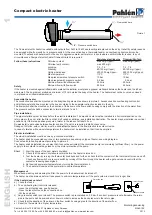
35
BULLETIN 45
THERMAL EXPANSION
SYMPTOMS
•
Effects are only noticeable after hot water use followed by periods of no water use.
•
Relief valve drips during any recovery cycle when no hot or cold water is used.
•
Hot water pipes creak while heater is recovering and all valves are closed.
•
Tanks or other components of the water supply system fail prematurely.
•
A metallic creaking noise might actually be heard in the location of the heater as
the pressure is relieved and the stretched tank returns to a natural shape.
•
Faucet drips during any recovery cycle when no hot or cold water is used.
•
Water surges when a faucet is
fi
rst opened and then pressure drops.
CAUSE
The water in a water heating system expands when it is heated and increases in
volume. Since water will not compress (like air), system designers must include
provisions for thermal expansion. (Water in a closed tank at 50 psi, when heated just
10 degrees, will reach a pressure of 250 psi).
Many water supply systems have check valves or back
fl
ow preventers at the water
meter to prevent any possible contamination of the public water supply by the
accidental back-
fl
ow of contaminated water into the supply mains. These check valves
are often required by code, and some cities are even installing the check valves. They
serve a useful purpose. Do not remove them!
The use of pressure reducing valves (PRV) is another cause. PRVs are designed to
conserve water and prolong
fi
xture life. Many PRVs also act as very effective check
valves. Again, do not remove them!
Water softeners in the system may also act as back-
fl
ow preventers.
TEST
Follow these easy steps to diagnose thermal expansion:
•
Turn the heater thermostat all the way down, and install a water pressure gauge
with dead hand on the drain valve. Open the drain valve, so the gauge reads
system pressure.
•
Open a hot water tap and allow 15% to 20% of the tanks volume to run out. Shut
off the drain valve and make sure that no other
fi
xture in the system, hot or cold, is
open. Make sure that outside
fi
xtures, if they are on the same system, are turned
off too. Any water leaks or use will make the test meaningless.
•
Check the water pressure gauge, and turn the pointer so it lines up with the
pressure indicating needle. Turn the thermostat back up to its normal position, so
the heater cycles on. Watch the pressure gauge.
•
If the system is closed, the pressure will start to climb steadily and rapidly. A
small amount of thermal expansion control may be built into the system because
of trapped air pockets or a water hammer arrestor. In that case the pressure
will increase slightly, hold steady for a short time and then rapidly increase. The
temperature and pressure relief valve (T&P) or PRV should open and release
water once the pressure reaches the maximum setting on the valve. The valve will
close once the pressure falls below the pressure setting of the valve.
Содержание GCV Series
Страница 2: ...2 ...
Страница 41: ...41 NOTES ...
Страница 42: ...42 NOTES ...
Страница 43: ...43 ...










































